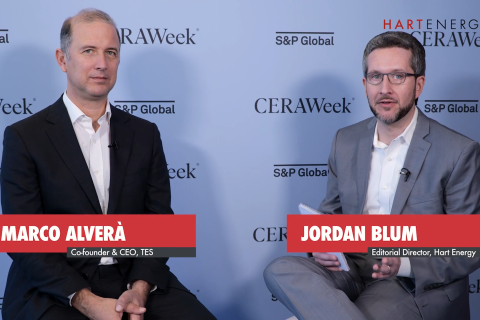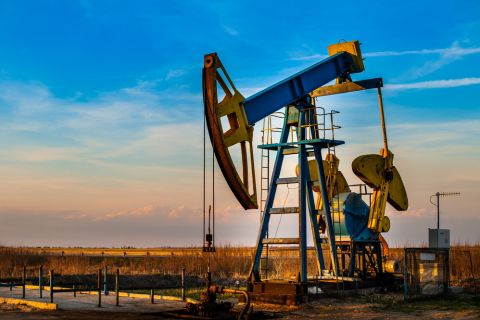
In the Permian Basin, Chevron signed a 12-year power purchase agreement, under which it will buy electricity from a West Texas wind farm to power its oil and gas operations in the basin. (Source: Chevron Corp.)
Big Oil is paying increasingly more attention to the energy transition—as illustrated by separate announcements from Royal Dutch Shell Plc and BP Plc earlier this month. The trend is not limited to Europe, but the supermajors on both sides of the Atlantic are taking different approaches to going greener.
Renewable Power
Shell Australia unveiled plans on Feb. 7 that it would build and operate its first industrial-scale solar farm in Queensland State. The solar farm will help power Shell’s QGC gas project.
Shell Australia did not respond to Hart Energy’s request for comment, but a company statement said the 120-megawatt (MW) solar farm, known as Gangarri, would reduce CO₂ emissions by around 300,000 tonnes per year. The facility will have around 400,000 photovoltaic panels, and is expected to be in service in early 2021. Shell plans to be the foundation customer for the project, as well as buying an equivalent amount of electricity from the national grid for its QGC operations.
“We believe solar will play an increasing role in the global energy system, especially when partnered with a reliable energy source such as gas,” Shell Australia’s chairman, Tony Nunan, said in the statement.
RELATED:
BP’s Net-Zero Goals See The Major Dwindle Oil Activity
Opinion: Big Oil Is Facing An Existential Struggle
Greg Joiner, vice president for Shell Energy in Australia, added: “We are increasingly incorporating renewable energy into customer offers, as we have done here for QGC, by combining renewable energy with a firmed energy solution offering reliable supply, a fixed price and a cleaner lower emission package.”
Shell is not the only supermajor to turn to renewables for powering its oil and gas operations. Both U.S.-headquartered oil giants Chevron Corp. and Exxon Mobil Corp. have announced plans for using renewable power for certain projects.
“The world needs more energy and more forms of energy,” Chevron’s external affairs advisor, Jan Sieving, told Hart Energy. “Chevron believes renewable energy sources play a role in meeting future energy demand and is investing in new projects such as the SunPower solar project in California and wind projects in Texas.”
Sieving added that renewable energy projects will provide cost-effective power options to San Ramon, Calif.-based Chevron’s operations.
“On an ongoing basis, we’re committed to evaluating new renewable sources that are scalable, economically viable and aligned with our business assets,” he said.
In California, Chevron is tapped SunPower, majority-owned by France’s Total SA, to construct Lost Hills Solar Project.
The system of solar panels will help power Chevron's Lost Hills oil field in California’s Kern County for up to 20 years. The project, announced last October, is expected to produce more than 1.4 billion kilowatt-hours (kWh) of solar energy, reducing CO₂ emissions by around 1 million metric tons.
The wind projects that Sieving referred to, meanwhile, are aimed at powering Chevron’s operations in the Permian Basin.
In May 2019, the company signed a 12-year power purchase agreement, under which it will buy electricity from a West Texas wind farm. The agreement covers Chevron’s electricity demand in the Permian at the time the deal was struck, but the company’s power needs are expected to grow. As a result, it says it continues to explore additional renewable opportunities in the basin.
Like Chevron, Irving, Texas-based Exxon Mobil has turned to renewables to power some of its operations in the Permian Basin. In November 2018, the supermajor said it was buying 500 MW of wind and solar power from projects in Texas operated by Denmark’s Orsted AS, with supplies starting in 2020.
Different Strategies
While all supermajors are taking steps to harness renewables for powering their oil and gas operations, clear differences in their strategies can be observed.
Chevron and Exxon Mobil, whilst being willing to buy renewable power, are less involved in developing solar and wind projects of their own. For example, Chevron sold off its renewable energy subsidiary in 2014. Instead, the two U.S.-based supermajors are focused on minimizing emissions from their oil and gas operations, including through carbon capture and storage (CCS).
Meanwhile, the European-based supermajors have been much more vocal about diversifying into renewables. Total is targeting a renewable electricity generation capacity of 25 gigawatts (GW) by 2025. Shell said in 2017 that it would spend $1 billion to $2 billion per year on its New Energies division up to 2020.
Perhaps most notably, BP set a new goal Feb. 12 to become a net zero emissions company by 2050 or sooner. The move is in line with what investment bank Raymond James described as a “decarbonization megatrend.”
BP said that in order to achieve its net zero goal, it will “fundamentally transform its whole organization.” The plan potentially puts pressure on other supermajors—especially those that may be perceived to be lagging on green issues—to do more in this area.
Recommended Reading
Exclusive: Arjun Murti Talks Energy Transition, the Role of Oil, Gas in Meeting Energy Needs
2024-02-16 - Partner at Veriten Arjun Murti gives his perspective on global energy needs and addresses EV adoption in the U.S. in this Hart Energy LIVE Exclusive interview.
Exclusive: TES CEO Sees Electric Natural Gas as a Trillion Dollar Market
2024-03-26 - Marco Alverà, the co-founder and CEO of TES, details how electric natural gas from green hydrogen is a cheaper and easier to produce fuel and shares insight on its e-NG partnership with TotalEnergies, in this Hart Energy Exclusive.
Schneider Electric’s Heather Cykoski: Infused AI is Everywhere
2024-04-09 - Schneider Electric puts sensors in the technology it provides customers, creating the ability to gather data, predict operations and drive efficiency.
Amid Climate Scaremongering, Energy Execs Urge Engagement, Realism
2024-02-06 - From shale boom to net zero goals, industry experts grappled with the contradictions facing the energy industry during SPE’s Hydraulic Fracturing Technology Conference.
‘Growth Story’ for Oil: Rice's Kenneth Medlock on Demand Trends
2024-03-05 - Economics drive oil demand, not politics, Rice University’s Kenneth Medlock said during the International Drilling Conference and Exhibition in Galveston.






